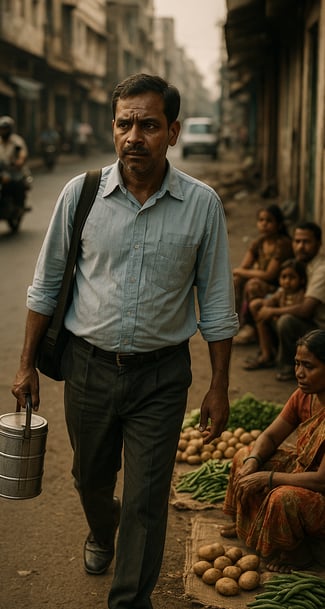The Unseen Warriors: The Economic Struggles and Strength of India’s Poor and Middle-Class Families
4/19/2025
In the heart of India’s bustling cities, dusty towns, and sprawling villages, live millions of families who fight silent battles every single day. They are the poor and the middle class—the ones who may not make headlines, but carry the weight of this nation on their shoulders.
They rise before the sun, work long hours, stretch every rupee, and dare to dream in a system that sometimes forgets them. This is not just about economics; this is about emotion, sacrifice, love, and the quiet strength of those who refuse to give up—no matter how hard life gets.
The Reality: Struggling, Yet Standing Tall
For the Poor:
Imagine a father who works as a daily-wage labourer. He doesn’t have the security of a monthly income. Some days, there’s work. Some days, there’s only hope. Yet, he ensures his children go to school, sometimes at the cost of skipping his own meal.
Imagine a mother in a slum area stitching clothes late into the night, eyes tired, hands sore, but heart full of courage because she knows education might be the only ticket out of poverty for her child.
These are not just people living in poverty. They are warriors fighting against a system that often pushes them down but never sees their courage.
For the Middle Class:
Now shift to the middle class—a teacher earning ₹30,000 a month, supporting a family of four. An accountant running his own small firm, chasing payments from clients to manage rent, school fees, and EMIs. A mother who manages the household like a CEO—with no salary, no break, no recognition.
They’re not poor, but they’re not free either. Every decision is weighed, every rupee is planned. A health emergency can shake their world. A job loss can bring months of anxiety. But still—they live with pride. They send their kids to tuition. They invest in LIC policies. They save for weddings, festivals, and future dreams.
Struggles Faced by the Poor
1. Unstable Employment
Most of the poor work in the unorganized sector. Their jobs are seasonal, informal, and lack benefits like pensions or insurance. Construction workers, housemaids, farm laborers—they have no job security.
2. Limited Access to Education
Government schools are often poorly equipped, and private education is unaffordable. As a result, children from poor families either drop out early or receive substandard education, limiting upward mobility.
3. Healthcare Burden
Most poor families cannot afford private healthcare. In emergencies, they either borrow money or delay treatment. Public hospitals are overcrowded and often under-resourced.
4. Debt Trap
Due to lack of access to formal credit, many rely on local moneylenders who charge high interest. This leads to long-term debt cycles that are hard to escape.
Struggles Faced by the Middle Class
1. Income vs Inflation
Middle-class incomes do not grow at the same pace as inflation. Whether it’s petrol, groceries, school fees, or electricity bills—expenses keep rising, but salaries remain relatively stagnant.
2. Tax Pressure
While they don’t earn enough to be considered “rich,” the middle class pays a significant share of the country’s income tax. They receive limited benefits in return—no free healthcare, no subsidies, no safety net.
3. Education Costs
Middle-class families prioritize education, but quality schooling and coaching come at a high cost. A major portion of household income is spent on children’s education, tuitions, and college fees.
4. Healthcare and Insurance
Private health insurance is expensive, and public health facilities are not always dependable. A medical emergency can drain years of savings.
5. Home Ownership
Buying a house is a major aspiration—but high property prices, loan EMIs, and stamp duty make it a long-term financial burden rather than a step toward security.
Challenges Common to Both
Lack of Social Security: There is minimal coverage in terms of pension, disability benefits, or unemployment insurance for the working poor or the informal middle class.
High Cost of Living in Urban Areas: Whether poor or middle class, urban life comes with steep rent, transport costs, and inflated daily expenses.
Inconsistent Government Support: Welfare schemes often don’t reach the poor due to poor targeting or corruption. Middle-class families often fall between the cracks—not poor enough for subsidies, not rich enough to afford services privately.
Job Market Instability: Automation, layoffs, and shrinking public sector jobs mean that even degree-holding individuals face underemployment or job insecurity.
The Way Forward: Policy and Practice
While these economic struggles are deep-rooted, there are areas where targeted action can help:
Better Implementation of Welfare Schemes: Government schemes for housing, education, and health must be streamlined to actually reach the poor.
More Tax Relief for the Middle Class: Reworking tax slabs and increasing deductions on essentials like healthcare and education would ease financial pressure.
Affordable Education and Skill Development: Government and private sector must expand vocational training and skill-building programs to improve employability.
Healthcare Infrastructure: Public health must be strengthened to serve both poor and middle-income families, reducing their dependency on costly private hospitals.
Support for Small Businesses: The middle class also includes entrepreneurs and self-employed workers. Credit access, tax holidays, and digital support can help them grow and survive.
Conclusion: Survival, Not Comfort
India’s poor and middle-class families do not seek luxury—they seek stability. They want jobs that pay fairly, schools that teach well, hospitals that treat without emptying savings, and policies that acknowledge their contribution.
They do not expect miracles from the government or society. What they need is recognition, practical support, and systems that don’t work against them. Until then, their struggle continues—not with complaint, but with quiet determination.
Disclaimer:
The views expressed in this blog are for general informational purposes only. They are based on publicly available data, personal observations, and general economic trends in India. This content does not constitute financial, legal, or policy advice. Readers are encouraged to conduct their own research and consult with professionals for personalized guidance. The situations described are generalized and may not represent every individual's or family's experience.


